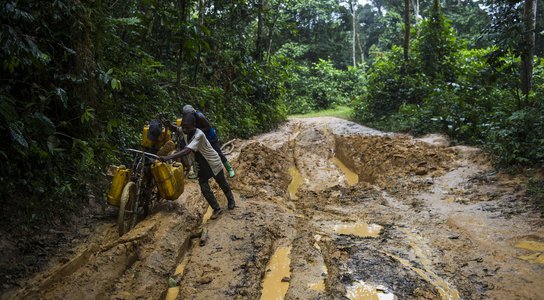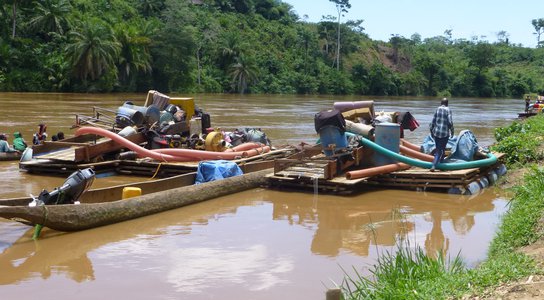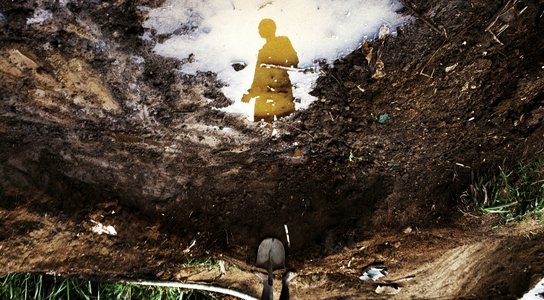Executive Summary
An estimated $28 billion worth of gold lies under the soil in eastern Democratic Republic of Congo (hereafter Congo).[i] But the country’s gold wealth, the majority of which is artisanally mined, has long been ill-used. Preyed upon by armed groups, bandits and corrupt elites the revenues generated by eastern Congo’s artisanal gold sector have all too often funded corruption or fuelled abuses and violent conflict rather than helping to relieve the region’s poverty.
Global Witness’ investigation into a recent gold rush along the Ulindi River in Shabunda territory in eastern Congo reveals the extent of the problems that beset the region’s artisanal gold sector. The Ulindi boom generated more than a tonne of gold per year, worth around $38 million,[ii] whose beneficiaries included armed groups and a predatory Chinese-owned company, Kun Hou Mining, rather than the local population.
Global Witness research reveals that Kun Hou Mining paid Raia Mutumboki armed groups operating along the banks of the Ulindi $4,000 and gave them two AK-47 assault rifles in order to secure access to rich gold deposits on the river bed. Kun Hou Mining ran four semi-industrial river dredging machines along the Ulindi in the boom. Members of the same armed groups also earned up to $25,000 per month by regularly taxing the workers on locally-made dredgers who were doing the dangerous job of manually sucking up gold from the river bed.[iii] Up to 150 of these manually operated dredgers worked along the river at the height of the rush. South Kivu officials charged with oversight of the province’s artisanal gold sector appeared to defend Kun Hou Mining rather than enforce Congolese law and hold the company accountable for its illegal activity.
In some cases, the same authorities worked hand-in-hand with armed men and women from Raia Mutumboki armed groups to illegally tax artisanal gold diggers, in violation of Congolese law. Mining authorities in Bukavu, the regional capital, falsified declarations of origin for the small quantities of Shabunda’s artisanal gold that were officially exported in order to obscure its origins, which are considered “high risk” by international standards.
Global Witness has seen documents that show that at least 12kg of Ulindi gold that had benefited armed groups was exported by a South Kivu gold trading house to its sister company in Dubai.[iv] But the majority of the boom’s gold – and taxes levied on it – have disappeared, almost certainly smuggled out of the country. South Kivu’s provincial accounts for 2014 and 2015 show no evidence of a gold rush. The gold boom left Shabunda town almost as it found it: a deprived enclave with no roads, running water or electricity and its people suffering grinding poverty.
Gold booms are not uncommon in Congo and Shabunda is not an isolated case: four-fifths of eastern Congo’s artisanal miners work in the gold sector.[v] Semi-industrial dredging companies, often Chinese-owned, have been accused by Congolese provincial officials and others of not paying taxes and smuggling gold out of the country in other parts of eastern Congo.[vi] Hundreds of millions of dollars of artisanally produced gold from the country’s east – which may have fuelled human rights abuses and violence – end up on global markets each year, often passing through transit countries such as Uganda, United Arab Emirates (UAE) and Switzerland.[vii] Ultimately the gold ends up in products like jewellery and electronic circuit boards sold around the world.
Shabunda’s gold rush could have played out very differently. Since 2010 companies all along gold supply chains have had access to international guidance developed by the Organisation for Economic Cooperation and Development (OECD) and the United Nations (UN). This guidance helps them source and trade gold from high-risk areas like Shabunda in a responsible way. Companies operating in Congo’s gold sector have been legally required under Congolese law to implement the OECD guidance since 2012. Recent Chinese industry due diligence guidelines for responsible mineral supply chains,[viii] based on the OECD guidance, provide directions and advice for companies like Kun Hou Mining to help ensure that their operations are not linked to abuses. Guidelines introduced in the UAE in 2012 make clear that all Dubai Multi Commodities Centre members and non-members should manage their supply chains according to the OECD principles. In order for these reforms to translate into meaningful changes in conflict-affected and high risk areas like Shabunda, governments must hold companies and public officials involved in abuses to account.
Companies either producing or internationally trading Shabunda’s gold did not implement these supply chain due diligence standards. Those companies operating in Congo acted in direct contravention of Congolese supply chain due diligence laws, which Congolese authorities failed to enforce. As a consequence, gold that benefitted armed men and a company operating illegally was left unchecked and traded internationally. Meanwhile the boom and its accompanying huge influx of gold diggers put pressure on already scarce resources in Shabunda town, pushing up food prices and leaving many local people unable to make ends meet. At the same time, mining authorities in Shabunda town ran an illegal taxation racket and, where gold was officially taxed, failed to deposit revenues with the Provincial government. This money is badly needed: in 2014 the town’s only hospital recorded 535 cases of malnutrition.[ix]
Eastern Congo’s artisanal gold production should benefit Congolese people and the state rather than armed men and predatory companies. For this to happen:
The Congolese government must hold provincial officials to account where they neglect their duties related to the artisanal gold sector or operate illegally. Companies operating illegally in Congo, such as Kun Hou Mining, should be investigated, and where evidence of wrongdoing is found, prosecuted.
Companies at all stages along global gold supply chains must implement the OECD due diligence guidance on responsible mineral supply chains. This includes publishing an annual report detailing the risks found in their supply chain and the measures taken to reduce these.
States have an obligation under international law to ensure companies respect human rights.[x] As such, they must legally require companies under their jurisdiction to undertake OECD standard supply chain due diligence, and must effectively monitor its implementation.[xi] Companies that fail to meet international supply chain due diligence standards laid out by the OECD must be held to account.
Artisanal miners operating in eastern Congo must be properly supported by the Congolese government. SAESSCAM, the Congolese state agency charged with oversight of the artisanal sector, must be urgently reformed or else disbanded.
Finally, donor governments should support diplomatic and development initiatives to promote responsible sourcing and support the Congolese government in establishing sustainable livelihoods for communities in areas where natural resources are extracted. Nascent and still localised efforts to formalise and manage artisanal gold supply chains should be supported and encouraged by governments and the private sector.[xii]
MethodologyGlobal Witness
engages with companies, governments and other partners around the world to
tackle the issue of natural resource-funded conflict. For the past 15 years we
have reported on the links between the trade in minerals and armed conflict in
eastern Democratic Republic of Congo, working with Congolese civil society,
policy-makers and business leaders to develop practical solutions.
Global Witness undertook research in Shabunda town, the eponymous hub of South Kivu’s Shabunda territory, on two occasions in 2015 and conducted further interviews in Bukavu, South Kivu’s provincial capital, on three separate occasions in 2014 and 2015. In total we interviewed over 80 people involved in the gold boom that erupted along Shabunda’s Ulindi River in 2013. Interviewees included gold divers, dredge workers, traders and businesspeople brought to Shabunda town by the gold rush as well as local residents, authorities and civil society. We also spoke to a whistle-blower from Kun Hou Mining.
An excellent August 2015 publication by the Great Lakes civil society platform COSOC-GL (the Coalition of Civil Society Organisations in the Great Lakes Region) raised several important and unanswered questions about the Ulindi gold boom and has proved a comprehensive resource. [xiii]
[i] OSISA, 2013, “The High Cost of Congolese Gold”, http://www.osisa.org/sites/default/files/high_cost_of_congolese_gold_final.pdf, p.16. Using an international gold price of US$38.5/g the estimated 26 million ounces (737, 087kg) would be worth $28,377,849,500.
[ii] Global Witness calculations for the volumes of artisanal gold produced during the gold boom along the Ulindi River are based on documents collected and interviews during fieldwork in Shabunda town in January and March 2015 and in Bukavu in 2014 and 2015 and documents provided by South Kivu’s mining agency SAESSCAM and Mining Division, as well as estimations provided by an industry expert familiar with Kun Hou’s operations along the Ulindi River. We estimate that the four semi-industrial dredging machines owned by Kun Hou Mining produced around 460kg of alluvial gold per year and over 150 locally-made artisanal dredging machines produced between 550kg and 720kg for the same period. In total we estimate that the two types of machines produced 1,010kg to 1,180kg. To calculate the value of this gold we used a gold price of $38.5/gram, which is an average for the international gold price spanning the period of the gold boom (exact range for calculations is between $38.89 million and $45.43 million). Gold traders interviewed by Global Witness in Shabunda town were selling their gold at the international market price, a phenomenon that is not uncommon at artisanal gold sites in eastern Congo See endnote 3 on calculations for artisanal gold production and taxes by Raia Mutumboki armed groups and endnote 43 on Kun Hou Mining calculations.
[iii] Global Witness estimates that 150 locally-made artisanal dredging machines produced between 550kg and 720kg per year during the gold boom. This estimation was made on the basis of three separate sources including interviews with dredge workers on the Ulindi River and other documents from Shabunda and Bukavu. From these we identified a range of average weekly gold production for artisanal dredgers between 77g and 100g. (The first is partial data from SAESSCAM South Kivu breaking down artisanal dredge production on the Ulindi over a three week period by dredger that shows an average of 77g of gold produced per artisanal dredge per week. The second is from statistics from a gold trading house based in Shabunda town that owns dredgers operating on the Ulindi, which show an average production of 99g per dredge per week. The third data point comes from interviews with dredge workers active along the Ulindi River from which we take an estimated weekly production of around 100g.) Dredge production varies from week-to-week and depending on deposits along the river, as well as other factors including weather and mechanical breakdowns. Also, due to the clandestine way in which the Ulindi’s gold has been managed and traded only general estimates are possible. Global Witness estimates assume gold production along the Ulindi based on 150 dredgers working for 48 weeks per year thereby setting aside one month per year for breakdowns and other production stoppages. (Exact calculations are: 77g per week produced by 150 dredgers working 48 weeks a year equals 554.4kg and 100g per week produced by 150 dredgers working 48 weeks a year equals 720kg.) Several sources estimate that 50 of the 150 dredgers on the Ulindi were operating in an upstream portion of the river under control of Raia Mutumboki armed groups. Dredge workers on the Ulindi River told Global Witness in March 2015 that Raia Mutumboki groups on each side of the river taxed dredgers in areas they control 5g of gold per group twice per month – this amounts to almost $20,000 per month for the groups. Added to these payments, each dredge worker operating in areas controlled by armed groups must pay them 1000 Congolese Francs per week. Dredge workers showed Global Witness receipts (‘jetons’) for these payments. Finally, dredges regularly have to contribute ‘rations’ to armed groups of up to 80,000 Congolese Francs per month. Taken together this amounts to up to $25,000 per month earnings for the armed groups. (Exact calculations: 5g collected twice per month from 50 dredgers equals 500g per month, using a price of $38.5/g is the equivalent of $19,250. For ‘jetons’, 50 dredgers each with 10 workers paying 1000 Congolese Francs each week equals 2,000,000 Congolese Francs per month. Rations of 80,000 Congolese Francs per dredge for 50 dredgers per month equals 4,000,000 Congolese Francs. At an exchange rate of 960 Francs to 1 US dollars, this combined 6,000,000 Congolese Francs is worth $6,250. The $19,250 taxed in gold plus the $6,250 taxes on dredge workers and ‘rations’ equals $25,500 per month.) These calculations do not include other taxes by armed groups including a mooring payment of $500 per dredge. Other groups operating under the name “Raia Mutumboki” may also have imposed taxes during the same period but are not included in these calculations. See also COSOC-GL (Coalition of Civil Society Organisations in the Great Lakes Region), 2015,“Etude sur les pratiques de dragues à Shabunda: La ruée vers l’or à Shabunda“, http://cosoc-gl.org/2015/la-ruee-vers-lor-a-shabunda/, Section 4; Tages Anzeiger, December 2015, Goldrausch im wilden Osten, http://www.tagesanzeiger.ch/wirtschaft/goldrausch-im-wilden-osten/story/20233121
[iv] Publicly available annual export reports complied by the provincial Mining Division in Bukavu show that all of Alfa Gold DRC’s legal gold exports from South Kivu in 2014 and 2015 were exported to Alfa Gold Dubai.
[v] IPIS, 2014, “Analysis of the Interactive Map of Artisanal Mining Areas in Eastern DRC: May 2014 update”, http://ipisresearch.be/publication/analysis-interactive-map-artisanal-mining-areas-eastern-drc-may-2014-update/, p.11
[vi] Global Witness has seen official documents from the provincial Ministry of Mines in (former) Orientale Province, dated February 2015, which detail illegal activities and environmental damaged by semi-industrial dredges along the River Ituri and River Aruwimi, Ituri; see also research conducted by PAX, 2015, “Exploiter (dans) le désordre Cartographie sécuritaire du secteur aurifère à Mambasa occidental“ http://www.paxchristi.net/news-media/resources-pax-christi-member-organisations ; and Southern Africa Resource Watch (SARW), 2014, “Congo’s Golden Web: The people, companies and countries that profit from the illegal trade in Congolese gold” http://www.sarwatch.org/sites/sarwatch.org/files/Publications_docs/congogold3web.pdf p.38
[vii] See for example: Stop-Pillage, 2013, TRIAL, 2013, ”TRIAL files a criminal denunciation to the Swiss Federal Prosecutor against a Swiss refinery company suspected of laundering looted gold from the Democratic Republic of the Congo”
[viii] Global Witness, 2015, Global Witness welcomes progressive new Chinese Mineral Supply Chain Guidelines, https://www.globalwitness.org/en-gb/press-releases/global-witness-welcomes-progressive-new-chinese-mineral-supply-chain-guidelines/
[ix] Global Witness interview, Shabunda town, March 2015.
[x] For example Congo has ratified all eight of the ILO fundamental conventions, which are legally binding international treaties http://www.ilo.org/dyn/normlex/en/f?p=1000:11200:0::NO:11200:P11200_COUNTRY_ID:102981
[xi] See also Civil Society Statement at the 10th Forum on Responsible Mineral Supply Chains https://www.globalwitness.org/en/campaigns/conflict-minerals/civil-society-statement-10th-forum-responsible-mineral-supply-chains-paris-10-12-may-2016/
[xii] Partnership Africa Canada (PAC), 2015, “Just Gold”, http://www.pacweb.org/en/just-gold
[xiii] COSOC-GL, 2015


